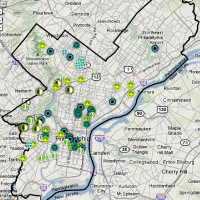Planting Day Crowns Project to Improve School with Green Infrastructure, SMIP Grant

Trees, permeable pavement and a rain garden all make the Lea schoolyard a better place for kids and Philadelphia’s waterways. Credit: WPCNS
Since 2012, Philadelphia Water has worked with members of the Lea Elementary School community and a number of partners to redesign their schoolyard and the surrounding area in a way that benefits the students, the neighborhood and our local waterways.
This Saturday, the volunteers behind the effort will be putting the finishing touches on some of that work, and you’re invited to join them.
Located at 47th and Spruce streets in the Walnut Hill neighborhood, Lea Elementary has been the focus of efforts by the West Philadelphia Coalition for Neighborhood Schools (WPCNS) to improve local public schools. Called “Greening Lea,” the ambitious project successfully transformed the school’s 41,000-square-foot asphalt lot into a vibrant green space and play area that also manages stormwater runoff with a number of green tools.
Besides being a beautiful community space, the improved Lea schoolyard—recently honored by the Sustainable Business Network as “Best Public Project” during their Excellence in GSI Awards—offers a valuable learning opportunity for parents and communities interested in similar projects.
Much of the work was completed during the fall of 2015 with the help of a $242,000 grant from Philadelphia Water’s Stormwater Management Incentives Program, which encourages green stormwater infrastructure investments on non-residential properties.
Today, 5,525 square feet of permeable brick pavers, 19 new trees, and 3,000 square feet of rain gardens at Lea are helping to slow, store and filter stormwater every time it rains.
Those green tools are designed to capture about 58,660 gallons of stormwater during a one-inch rain storm. That’s the same as hooking up nearly 1,200 homes to 50-gallon rain barrels.
On Saturday, WPCNS will host a community volunteer day to put plants in the final rain garden, which was completed in the fall. Spring cleanup and maintenance will spruce up the other two rain gardens, and volunteers will also weed, install a rope fence and work on a “Food Forest” created with the help of the Philadelphia Orchard Project.
The event is open to the public, and the community day offers a great opportunity for those who want to see what a truly transformed neighborhood schoolyard can offer. Sign up here.
Parents and communities interested in improving their local schools should take a good look at the process that it took to make Lea as green as it is today. WPCNS and the Greening Lea partners engaged a tremendous network that included parents, students, teachers, elected officials, community groups, neighbors, design professionals, private companies, public agencies like Philadelphia Water, and private/public partnerships like the Schuylkill River Restoration Fund.
“This project brought together so many different groups in our community and we are excited to see it becoming a beautiful, vibrant space,” says Julie Scott, co-chair of the Greening Lea project.
It took years of hard work and hundreds of thousands of dollars in grants and donations, but today, the students of Lea can enjoy a school that is a greener, more engaging space for learning and play.
To see that transformation yourself, head over to Lea this Saturday and help them plant that last rain garden. You’ll be impressed, and hopefully inspired too.
Want to learn more about what it took to make Lea a green, stormwater-pollution fighting oasis? Read this case study from the Community Design Collaborative, which helped WPCNS create the master plan for Lea's rebirth.





